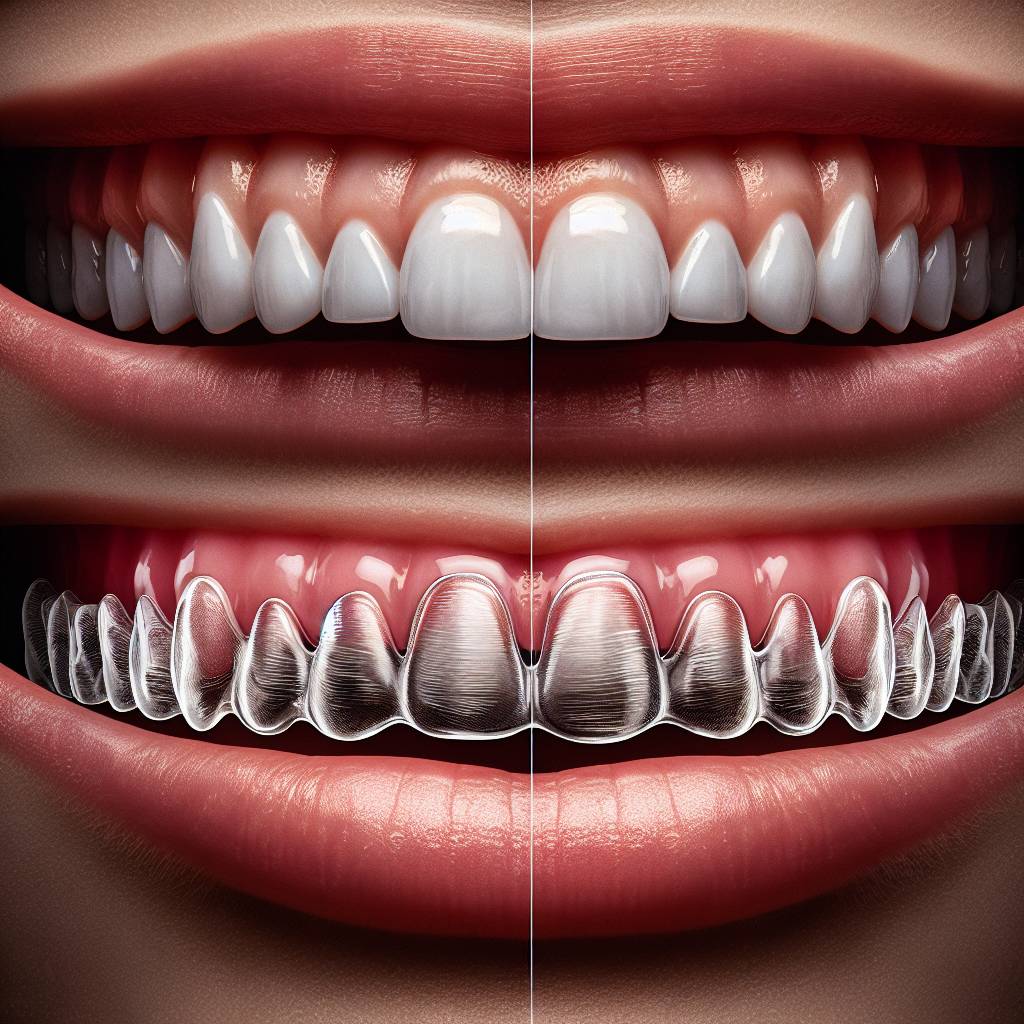Invisalign is a popular orthodontic treatment that uses a series of custom-made, removable aligners to move teeth into the desired position. While Invisalign is known for its convenience and discretion, many people are curious about how far it can actually move their teeth. This article will explore the answer to this question and provide important information on what to expect from an Invisalign treatment.Invisalign is an orthodontic treatment that uses clear aligners to move teeth into the desired position. The amount of movement that can be achieved with Invisalign depends on the severity of the patient’s malocclusion, as well as the complexity of their case. Generally, Invisalign can move teeth up to 10 millimeters in any direction.
What to Expect from Invisalign Treatment
Invisalign is a modern orthodontic treatment used to straighten teeth without the need for traditional metal braces. It uses a series of clear, removable aligners that are custom-made for each patient. Invisalign treatment is usually recommended for adults and teenagers who have mild to moderate misalignment of their teeth.
In order to begin the Invisalign treatment process, a patient will first need to schedule an initial consultation with an orthodontist or dentist. During this consultation, the doctor will examine the patient’s teeth and discuss their goals for treatment. If Invisalign is deemed suitable for the patient, impressions of their teeth will be taken and sent to a laboratory where the aligners are custom-made.
Once the aligners are ready, they will be sent to the doctor’s office where they can be fitted onto the patient’s teeth. The patient will then wear each set of aligners for two weeks before switching them out for another set in order to gradually move their teeth into alignment. The total duration of treatment can vary depending on each individual case but typically takes between nine and 18 months.
Patients should expect some mild discomfort when first wearing their aligners as their teeth adjust to being moved into a new position. This discomfort usually fades after about one week and patients may also experience some minor speech impediments while wearing their aligners as they get used to speaking with them in place.
Regular visits with the orthodontist or dentist are necessary throughout the course of Invisalign treatment in order to monitor progress and make any necessary adjustments along the way. Once treatment is complete, patients may need to wear a retainer in order maintain their new smile over time. With proper care and maintenance, Invisalign can help patients achieve beautiful straight smiles without having to worry about metal braces or wires!
What Causes a Tooth to Move?
Tooth movement is caused by a number of factors, including age, genetics, diet and lifestyle. In general, the process of tooth movement begins when the jawbone and gum tissue around the teeth begin to recede. As this happens, teeth can become loose and start to move out of their original position.
Age plays an important role in tooth movement as bones tend to become weaker with time. As we get older, our teeth can shift due to changes in bone density or receding gums. Genetics also play a role in tooth movement; some people are more prone to having misaligned teeth due to genetic predisposition.
Diet and lifestyle can also affect tooth movement. Sugary foods and drinks can cause bacteria to build up on teeth which eventually leads to enamel erosion and weakened tooth structure. In addition, smoking cigarettes or using tobacco products can be damaging for your oral health as it increases the risk of gum disease which, in turn, leads to tooth loss or misalignment.
Finally, certain medical conditions such as diabetes or autoimmune diseases can also lead to tooth movement as these conditions can weaken the bones in the jaw and cause them to recede faster than normal. Therefore it is important for people with these medical conditions to take extra care of their oral health by visiting their dentist regularly for checkups and cleanings.
In conclusion, there are many factors that can contribute to tooth movement including age, genetics, diet and lifestyle choices as well as underlying medical conditions. Therefore it is important for people of all ages and backgrounds to take care of their oral health by regularly brushing twice a day and visiting their dentist at least once a year for checkups and cleanings.
Benefits of Invisalign
Invisalign is a revolutionary orthodontic treatment that can help straighten your teeth without the need for traditional metal braces. It utilizes a series of clear, removable aligners to gradually realign teeth into their desired positions. As an alternative to traditional braces, Invisalign offers numerous benefits, including:
1) Increased Comfort – Invisalign aligners are made of smooth, comfortable plastic that won’t irritate your gums or cheeks like metal braces can. The aligners are also removable, so you don’t have to worry about food getting stuck in hard-to-reach places.
2) Improved Oral Hygiene – Because Invisalign aligners are removable, it’s much easier to brush and floss your teeth than with traditional braces. This helps keep your teeth and gums healthy throughout the treatment process.
3) Quicker Treatment Time – Invisalign treatments typically take between 6 and 18 months, depending on the severity of the case. This is significantly shorter than the 1-3 years required for traditional braces.
4) Enhanced Aesthetics – One of the most popular benefits of Invisalign is its virtually invisible appearance. The aligners are virtually undetectable when worn, so no one will even know you’re wearing them.
Overall, Invisalign is a great option for those looking to straighten their teeth in a comfortable, discreet way. With shorter treatment times and improved oral hygiene, it’s easy to see why more and more people are choosing Invisalign over traditional braces.
What Is the Average Amount of Tooth Movement Achieved with Invisalign?
Invisalign is an effective and popular orthodontic treatment that has been used to move teeth for over 20 years. The average amount of tooth movement achieved with Invisalign can vary depending on the complexity of a patient’s case and the experience of the doctor. However, typically a patient can expect to see a shift in their teeth of up to 6 millimeters in each arch (upper and lower jaw).
In some cases, it may be possible to achieve more than 6 millimeters of movement, but this depends on how much space is available in the mouth and how many aligners are needed to complete treatment. On average, most patients who complete Invisalign treatment experience between 4-6 millimeters of tooth movement each arch.
It is important to note that the amount of tooth movement achieved with Invisalign does not necessarily correspond to how much better a person’s smile looks after treatment. The degree of tooth movement obtained with Invisalign will ultimately depend on the amount of space available in the mouth and how well-aligned the teeth are prior to beginning treatment. Some patients may need more than 6 millimeters of movement to achieve their desired results while others may need less.
The best way to determine how much tooth movement you can expect from your Invisalign treatment is by speaking with your orthodontist. They will be able to assess your individual case and recommend an appropriate course of action that will best meet your needs and goals for achieving a beautiful smile.

How Long Does it Take for Teeth to Move with Invisalign?
Invisalign is a popular and effective orthodontic treatment that uses clear aligners to gradually move your teeth into the desired position. The length of treatment varies depending on the complexity of the case and how well you follow your doctor’s instructions. However, the average Invisalign treatment time is usually between 12 to 18 months.
In most cases, people will start to see results within a few weeks of beginning treatment. This is because the aligners create gentle pressure on your teeth, which helps them shift into their desired positions. As you progress through each set of aligners, your teeth will move closer and closer to their ideal shape and position.
Your Invisalign provider will be able to give you a more specific timeline for your particular case. However, it’s important to remember that some cases may require more time than others due to various factors such as severity of misalignment or how well you stick to wearing your aligners for the 22 hours per day recommended by doctors.
It’s also important to note that even after completing Invisalign treatment, there may be some additional “fine-tuning” needed in order for your teeth to reach their desired positions. This could include wearing retainers or using other orthodontic devices for a short period of time in order to achieve optimal results.
Overall, Invisalign can be a great way to get straighter teeth in a relatively short amount of time compared with traditional braces. With proper care and compliance with instructions from your provider, you should be able to see results within 12-18 months. For more information about how long it takes for teeth to move with Invisalign, talk to an experienced orthodontist today!
Does Invisalign Work for Crowded or Gapped Teeth?
Yes, Invisalign can be used to address both crowded and gapped teeth. Crowded teeth occur when there is not enough space for all of the teeth to fit comfortably in the mouth. Gapped teeth, also known as diastemas, occur when there is an unusually large space between two adjacent teeth. Invisalign works by gradually shifting the position of the teeth using a series of custom-made clear aligners. The aligners are made from a mold of the patient’s mouth and are designed to move the teeth in specific directions.
Invisalign can be used to treat mild to moderate cases of crowded and gapped teeth. It is important to note that Invisalign will not work for severe cases where the teeth are severely misaligned or overcrowded. In these cases, traditional braces may be required.
Invisalign is a great option for those who want to straighten their smile without having to wear metal brackets and wires on their teeth. The aligners are removable, so they can easily fit into your lifestyle and schedule without interfering with your daily activities or social life. Additionally, the aligners are virtually invisible compared to traditional braces, making it a great choice for adults who want an inconspicuous way to straighten their smile.
Overall, Invisalign can be an effective and discreet way to address both crowded and gapped teeth. It is important to consult with your orthodontist before deciding if Invisalign is right for you.Invisalign is an orthodontic treatment that uses a series of custom-made, removable aligners to straighten teeth. Although popular for its convenience and discreet appearance, it is important to understand that Invisalign is not suitable for all orthodontic cases. There are certain limitations to what Invisalign can accomplish.
Complex Orthodontic Cases
Invisalign is best suited for mild to moderate orthodontic cases. More complex cases may require more traditional treatments such as metal braces or other specialized techniques. Patients with severe crowding or deep overbites may need traditional braces in order to achieve the desired results.
Limitations on Tooth Movement
In addition, Invisalign can only move teeth within certain limits. It cannot move teeth vertically or rotate them more than a few degrees of rotation. It also cannot move teeth as quickly or effectively as traditional braces, which can be an issue for patients who need a quick result due to a specific event such as a wedding or job interview.
Cost Considerations
Finally, cost can be an important factor when considering Invisalign treatment. Depending on the complexity of the case and the number of aligners required, the cost of Invisalign treatment can be comparable to traditional braces in some cases, and significantly higher in others.
Overall, Invisalign is an excellent option for many people looking to straighten their teeth discreetly and conveniently. However, it’s important to understand that there are limitations to what Invisalign can accomplish and whether it’s the best choice for your particular needs should be discussed with your orthodontist before beginning treatment.

Conclusion
Invisalign is a fantastic orthodontic treatment option for straightening teeth. It is virtually invisible, comfortable to wear, and can move teeth up to two millimeters per aligner. The number of aligners needed for a successful treatment depends on the complexity of the patient’s case, but generally speaking, it takes between 12 and 48 aligners to complete treatment. Invisalign does not work for everyone, as some cases are better suited to traditional braces. However, the majority of people who use Invisalign have had great results from their treatments.
Overall, Invisalign is an excellent choice for anyone looking to realign their teeth in a discreet and comfortable manner. Its ability to move teeth up to two millimeters means that it can be used to treat mild or moderate cases of misalignment quickly and effectively. Before committing to any course of orthodontic treatment, it’s important that you consult with an experienced dental professional who can provide you with an accurate assessment of your individual needs.

